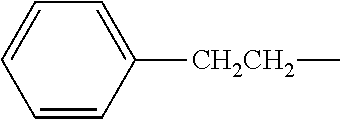Filtration article with microbial removal, micro-biocidal, or static growth capability
- Summary
- Abstract
- Description
- Claims
- Application Information
AI Technical Summary
Benefits of technology
Problems solved by technology
Method used
Image
Examples
examples 1-5
[0227]The treated filter media indicated in Table 5 was sampled by cutting 6 mm diameter discs from each treated sheet. The bacterial stocks were diluted 1:10,000 in sterile H2O to create testing stock, then 50 μl of the testing stock was pipetted directly onto each disc. The discs were allowed to sit for about 1 minute, then the disc was placed in a 2 mL microcentrifuge tube along with 1 mL of sterile H2O. The tube was mixed on an orbital shaker for 5 minutes at 120 rpm. Then the water from the tube was sampled and plated for counting.
[0228]Table 5 is a compilation of multiple experiments evaluating percent removal of the target organism using the column protocol described above. Bacterial loads were 1.0E03-1.2E04 cfu / disc. The table shows that the modified filtration media of the invention are capable of capturing and retaining substantial quantities of microorganisms.
TABLE 5Exam-pleFilter Fabric,Test Organism, % removalNo.Fabric TreatmentStaphE. ColiKlebsiellaSalmonella1LD, tetra...
examples 6-9
[0229]The treated filter media were sampled by cutting 6 mm discs from each treated sheet. The fit was removed from a Handee Spin column (obtained from Thermo Fisher Scientific (Pierce Protein Research Products) of Waltham, Mass.) and replaced with disc of filter media, which was then secured by an O-ring. The column was pre-wetted with 0.5 ml sterile H2O, and the flow-through was discarded. Bacterial stock was diluted 1:1000 by volume in sterile H2O to create testing stock. Then 0.5 ml of the testing stock was added to column. The flow-through was collected for plating. Then the column was washed with two washes of sterile H2O, 0.5 ml each, and these washes were also collected for plating. Controls were an empty column (inoculated and washed as described, wherein the plated out washes indicated that no bacteria were captured by the column), a bacterial control wherein an aliquot of the testing stock was plated out for comparison, and an unmodified filter media (see GENERAL PROCEDUR...
examples 10-14
[0232]Following the experimental procedures employed for Examples 6-9, multiple experiments evaluating percent removal of various organisms were carried out. Bacterial loads were 1.0-7.5E03 cfu / disc. The results, tabulated in Table 7, show that the modified materials of the invention are capable of capturing and retaining substantial quantities of microorganisms compared to the unmodified starting materials.
TABLE 7ExampleFilter Fabric,Test Organism, % removalNo.Fabric TreatmentE. ColiKlebsiellaSalmonellaC2LD, unmodified8242710LD, tetraethylene927645pentamine andpolyethylene imine11LD, tetraethylene567072pentamine andpolyethylene imine;Compound I12HD, tetraethylene918269pentamine andpolyethylene imine13HD, tetraethylene85——pentamine andpolyethylene imine;Compound IC3UHD, unmodified——14UHD, tetraethylene95——pentamine andpolyethylene imine
PUM
| Property | Measurement | Unit |
|---|---|---|
| Fraction | aaaaa | aaaaa |
| Dimensionless property | aaaaa | aaaaa |
| Dimensionless property | aaaaa | aaaaa |
Abstract
Description
Claims
Application Information
 Login to View More
Login to View More - R&D
- Intellectual Property
- Life Sciences
- Materials
- Tech Scout
- Unparalleled Data Quality
- Higher Quality Content
- 60% Fewer Hallucinations
Browse by: Latest US Patents, China's latest patents, Technical Efficacy Thesaurus, Application Domain, Technology Topic, Popular Technical Reports.
© 2025 PatSnap. All rights reserved.Legal|Privacy policy|Modern Slavery Act Transparency Statement|Sitemap|About US| Contact US: help@patsnap.com



